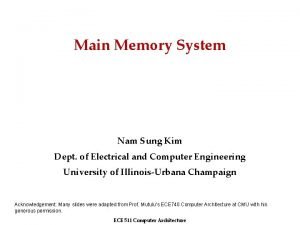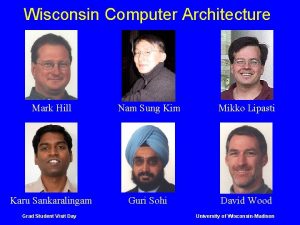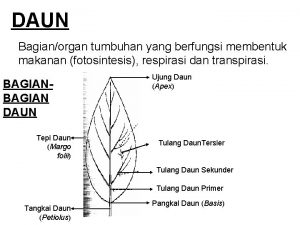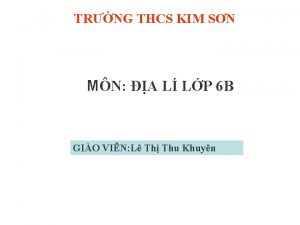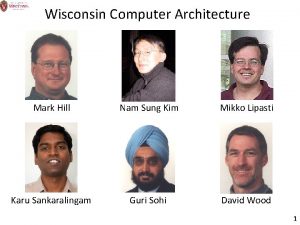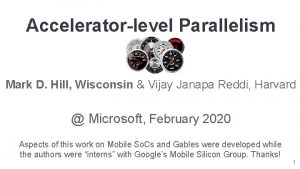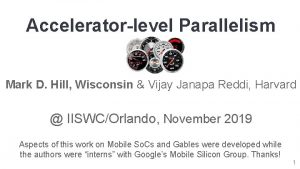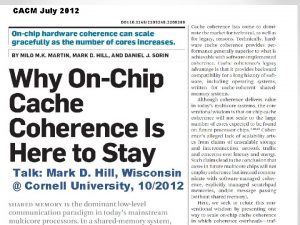Wisconsin Computer Architecture Mark Hill Nam Sung Kim











- Slides: 11

Wisconsin Computer Architecture Mark Hill Nam Sung Kim Mikko Lipasti Karu Sankaralingam Guri Sohi David Wood Grad Student Visit Day University of Wisconsin-Madison

Technology & Moore’s Law 35 nm Transistor 1947 Integrated Circuit 1958 Transistor today Moore’s Law 1964: # Transistors per IC doubles every two years (or 18 months) Grad Student Visit Day University of Wisconsin-Madison

Architects & Another Moore’s Law Microprocessor 1971 Intel Nehalem 2010 Popular Moore’s Law: Microprocessor performance doubles every two years Grad Student Visit Day University of Wisconsin-Madison

Houston, We Have Problems! • Memory Wall – 1980 Memory Latency ~ 1 instruction – 2008 Memory Latency ~ 1000 instructions • Other Problems – Power & cooling – Reliability – Complexity & test Grad Student Visit Day University of Wisconsin-Madison

Chip Multiprocessor (a. k. a Multi-Core) • Replicate – processor “core” & – Caches • • Uses more transistors Tolerates “memory wall” Simpler lower-power cores Reduces complexity Grad Student Visit Day University of Wisconsin-Madison

an Opportunity Houston, We Still Have a Problem -------- • Recall Popular Moore’s Law: – Microprocessor performance doubles every two years • Future CMP Performance Doublings Require – – Effective multithread programming! Better communication Faster synchronization More cores Grad Student Visit Day University of Wisconsin-Madison

Why Computer Architecture at Wisconsin? 1 of 2 • Strong History – processors: branch prediction, decoupled architectures, precise interrupts, out-of-order processors, pipeline clocking, speculative execution, speculative multithreading – memory: snooping coherence, 3 Cs model, memory consistency, non-blocking caches, token coherence – simulation: simplescalar, pharmsim, & GEMS • Strong Present – speculative multithreading, speculative coherence, chip multiprocessors, virtual machines, transactional memory – awards: Eckert-Mauchly, Wilkes, IEEE/ACM Fellows, National academy of engineering members – 20 grad students & several well-funded projects Grad Student Visit Day University of Wisconsin-Madison

Why Computer Architecture at Wisconsin? 2 of 2 • Former Graduate Students Prospering – Over a dozen in academia: CMU, Duke, Illinois, Maryland, Michigan, NCSU, U Penn, Purdue, Texas, Toronto • Nearly all winners of NSF CAREER awards • 4 winners of Sloan Research Fellowships – Several in key industrial positions: AMD, Cray, IBM, Intel, Sun, others • Includes principal architects of important products (Alpha 21264, Cray T 3 EX 1/) • Strong Future – We average 15 -20% ISCA papers since 2000 – Our grads average another 15 -20% – We want to add you to this slide! Grad Student Visit Day University of Wisconsin-Madison

Selected Projects 1 of 2 • Multifacet: Multicore design (Hill & Wood) – Recent: Log-based Transactional Memory – Future: Deterministic Execution & Replay • Vertical: Technology-driven architecture (Sankaralingam) – Relax: Reliability aware systems – Dy. SER: Energy efficiency through extreme specialization • Multiscalar: Processor Design (Sohi) – Past: Speculative multithreading and variants – Recent/Current: Non-traditional multicore architectures and solving the multicore programming problem. Grad Student Visit Day University of Wisconsin-Madison

Selected Projects 2 of 2 • Many-Core Power and Performance(Kim) – Power, performance optimization considering process variability – Reliable, low-power computing • Pharm: System and processor design (Lipasti) – Optimized software & hardware for commercial servers – Novel and power-efficient cache coherence and interconnects – High ILP processors with low power and low complexity Grad Student Visit Day University of Wisconsin-Madison

http: //www. cs. wisc. edu/~arch/uwarch Grad Student Visit Day University of Wisconsin-Madison
 Nam sung kim
Nam sung kim Mark hill wisconsin
Mark hill wisconsin Có công mài sắt có ngày nên kim
Có công mài sắt có ngày nên kim Ti dao si nam čvrstu riječ
Ti dao si nam čvrstu riječ Daun nam nam
Daun nam nam Bản đồ các đới khí hậu trên trái đất
Bản đồ các đới khí hậu trên trái đất Lịch sử hà nội từ năm 1802 đến năm 1884
Lịch sử hà nội từ năm 1802 đến năm 1884 Sung mi kim
Sung mi kim Nam ho kim
Nam ho kim Bus architecture in computer architecture
Bus architecture in computer architecture Difference between architecture and organization
Difference between architecture and organization Basic computer organization
Basic computer organization
